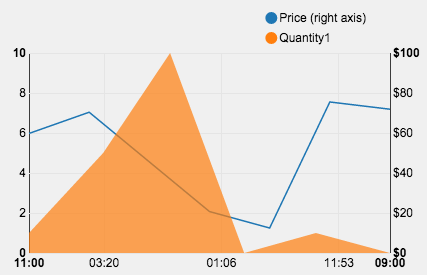In the example above you can see that the line is rendered under the orange area graph:
Was reading this trend here, then I tried this d3.select('svg#chart .lines1Wrap').moveToFront();, but got the error moveToFront is not a function.
Chart code
var data = [{
"key": "Price",
"type": "line",
"yAxis": 2,
"values": [
[1443621600000, 71.89],
[1443619800000, 75.51],
[1443618000000, 12.49],
[1443616200000, 20.72],
[1443612600000, 70.39],
[1443610800000, 59.77],
]
}, {
"key": "Quantity1",
"type": "area",
"yAxis": 1,
"values": [
[1136005200000, 1],
[1138683600000, 5],
[1141102800000, 10],
[1143781200000, 0],
[1146369600000, 1],
[1149048000000, 0],
]
}];
data = data.map(function(series) {
series.values = series.values.map(function(d) {
return {
x: d[0],
y: d[1]
}
});
return series;
});
nv.addGraph(function() {
var chart = nv.models.multiChart()
.margin({
top: 20,
right: 40,
bottom: 50,
left: 40
})
.yDomain1([0, 10])
.yDomain2([0, 100]) // hard-coded :<
.interpolate("linear") // don't smooth out the lines
.color(d3.scale.category10().range());
chart.xAxis.tickFormat(function(d) {
return d3.time.format('%I:%M')(new Date(d));
});
chart.yAxis1.tickFormat(d3.format(',f'));
chart.yAxis2.tickFormat(function(d) {
return '$' + d3.format(',f')(d)
});
d3.select('svg#chart')
.datum(data)
.transition().duration(500).call(chart);
d3.selection.prototype.moveToFront = function() {
return this.each(function() {
this.parentNode.appendChild(this);
});
};
d3.select('svg#chart .lines1Wrap').moveToFront();
chart.update();
nv.utils.windowResize(chart.update);
return chart;
});
UPDATE Found this answer here, tried to use the solution:
d3.selection.prototype.moveToFront = function() {
return this.each(function() {
this.parentNode.appendChild(this);
});
};
d3.selection.prototype.moveToBack = function() {
return this.each(function() {
var firstChild = this.parentNode.firstChild;
if (firstChild) {
this.parentNode.insertBefore(this, firstChild);
}
});
};
d3.select('svg#chart .lines1Wrap').moveToFront();
d3.select('svg#chart .nv-areaWrap').moveToBack();
No more error, however the blue line graph still is not moved in front of all the others.


d3.select('svg#chart .lines2wrap').moveToFront();still same results however... – Kletter